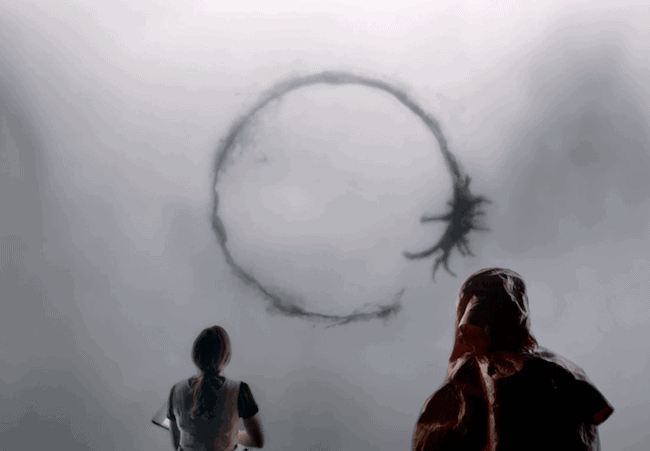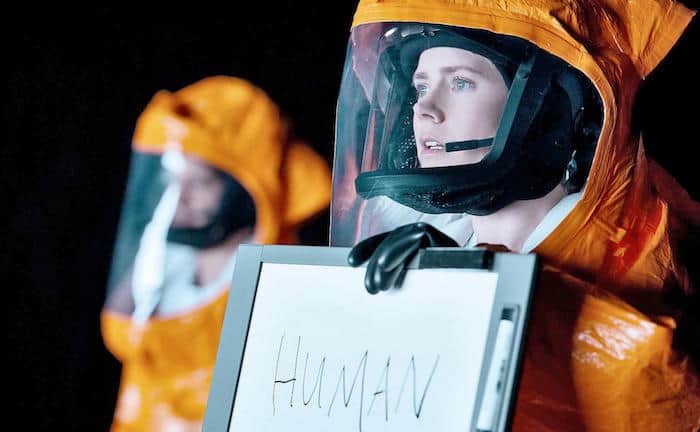This film will not get an Oscar. None. Especially not lead actor Amy Adams, who (wisely) was not nominated. Sound harsh? Be honest. When have you turned to your film-going companion and said, “hey, let’s go see that new Amy Adams flick.”? Never. The reason is that, despite the promotional ads taken out by her studio, producers, publicist, and/or mother, you don’t think about Amy Adams at all.
There’s a reason for this: she’s forgettable. Let me put that another way: she’s not memorable. To be a memorable actor you need either extravagant amounts of talent, or an intriguing, expressive face. Our greatest film stars have both, e.g. Meryl Streep, Jennifer Lawrence, Benedict Cumberbatch. Alas, Adams lacks physical excitement as well as acting energy. Certainly this is true in Arrival, the new film by Denis Villeneuve in which we are asked to believe that Adams is über linguist Dr. Louise Banks, contacted by the Army to help decode communications from a mysterious group of aliens that have come to earth.
 Dr. Banks brings her own emotional sufferings with her to the windswept plains of Montana where an enormous ovoid alien craft hovers, and opens its portal to receive inquiring scientists every 18 hours. The medium of moving pictures allows lavish ease of time-tinkering such that a film can show us flashbacks, flash-forwards, interspersed with imagined or perhaps remembered sounds, words, kisses, tears, and “events.” And Villeneuve uses such non-linear filmic devices in an attempt to inject intrigue into the character of Louise Banks, as well as to help cover-up what is otherwise a highly worn path of science fiction clichés.
Dr. Banks brings her own emotional sufferings with her to the windswept plains of Montana where an enormous ovoid alien craft hovers, and opens its portal to receive inquiring scientists every 18 hours. The medium of moving pictures allows lavish ease of time-tinkering such that a film can show us flashbacks, flash-forwards, interspersed with imagined or perhaps remembered sounds, words, kisses, tears, and “events.” And Villeneuve uses such non-linear filmic devices in an attempt to inject intrigue into the character of Louise Banks, as well as to help cover-up what is otherwise a highly worn path of science fiction clichés.
Borrowing freely from such film classics as Close Encounters, Apocalypse Now, The Day the Earth Stood Still, and E.T., this film was attractively bathed with music by Jóhann Jóhannsson and sound design by Montreal-based sound editor Sylvain Bellemare, whose team created uncanny sonic “language” for the amorphous aliens utilizing mixed and manipulated sounds of animals, metal, Maori flute, and water. Among others. But back to the main problem: casting.
 Some films soar into the stuff of indelible memories thanks to powerful performers and their mesmerizing screen presence. See my reviews of Lion, and Manchester by the Sea, for recent examples. By the exact same token, a film—even a film that has everything else going for it—can thud! because of weak performers in key roles. And in this case that’s Amy Adams, whose rounded features seem incapable of emotional import or expression, and the barely better Jeremy Renner as the bland linguist’s fellow researcher. In Retter’s case, his perfunctory performance was further sabotaged by a weak-kneed script and cliché-driven direction. [See Amy Adams’ face in the photo above? That’s the most “acting” she does in the entire film. This is her Meryl Streep moment.]
Some films soar into the stuff of indelible memories thanks to powerful performers and their mesmerizing screen presence. See my reviews of Lion, and Manchester by the Sea, for recent examples. By the exact same token, a film—even a film that has everything else going for it—can thud! because of weak performers in key roles. And in this case that’s Amy Adams, whose rounded features seem incapable of emotional import or expression, and the barely better Jeremy Renner as the bland linguist’s fellow researcher. In Retter’s case, his perfunctory performance was further sabotaged by a weak-kneed script and cliché-driven direction. [See Amy Adams’ face in the photo above? That’s the most “acting” she does in the entire film. This is her Meryl Streep moment.]
Lest you rise up indignantly and accuse me of body-shaming in the case of Adams, let me remind you that I, like so many others, paid good money to be swept away by the magic of cinema. I had high hopes for Arrival, a narrative about contact and communication with enigmatic extra-terrestrials. Producers spent a lot of money preparing a canvas upon which a handful of actors would deliver the story and create characters who were spellbound by what they found.
To create all of this you need performers capable of enormous intensity, especially when they are on-screen almost all the time, and their faces—rather than car crashes, explosions, and scenic vistas—are doing all of the work.
Adams Adams’ face can’t do the heavy-lifting required.
Simply the wrong choice upon which to hang a film. Helen Mirren, yes. Adams, no. So it’s not a mystery at all why her name does not turn up on the Best Actress list of nominees this year. No mystery at all.



I too, expected more of Amy Adams. After American Hustle, when I saw her in a different light than I ever had before, I actually did think, oh, Aliens AND Amy Adams! I’m glad I saw the movie, but I do think she is capable of more.
My husband loves Amy and talked me into going to see “Arrival.” (okay, the linguist angle influenced me too, since our daughter was a linguistics major).
He liked the movie more than I did. I thought it was very over-rated (wonderful reviews at the time). Yes, she was good in “American Hustle” (as was Jeremy Renner). She shouldn’t be penalized for having a sweet face. She’s no Jessica Chastain, but she has a certain screen appeal.